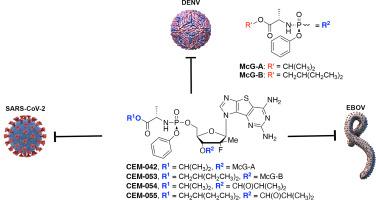Novel tricycle expanded purine nucleosides with pan-viral activity
IF 3
3区 医学
Q2 BIOCHEMISTRY & MOLECULAR BIOLOGY
引用次数: 0
Abstract
A series of thiophene-expanded tricyclic nucleosides featuring modifications not previously investigated, including sugar and nucleobase modifications, were synthesized as potential antiviral therapeutics. In addition, their corresponding prodrugs were also pursued to probe their potential antiviral activity, as typically prodrugs increase solubility and delivery. Initial interest was focused on ribose analogues as we had previously only synthesized a few compounds, and none had been tested against new viruses, particularly those of pandemic concern. In that regard, CEM-007, showed promising antiviral activity against several viral families. Given this promising lead, the 2′-α-fluoro-2′-β-methyl-modified analogues of CEM-007 were also synthesized for comparison. While 2′-modified analogue CEM-024 showed little to no antiviral activity, several of its prodrugs including CEM-042, CEM-052, CEM-053, CEM-054 and CEM-055, exhibited potent, broad-spectrum antiviral activity across several viral families including flaviviruses, filoviruses, and coronaviruses, with EC50 values in the single digit low micromolar range, with minimal toxicity. Additional studies are underway to elucidate the mechanism of action of these analogues. The design, synthesis, and biological testing of these structurally novel analogues are reported herein.

具有泛病毒活性的新型三环扩增嘌呤核苷
一系列噻吩扩展的三环核苷具有以前未研究的修饰,包括糖和核碱基修饰,被合成为潜在的抗病毒治疗药物。此外,我们还研究了它们相应的前药,以探测它们潜在的抗病毒活性,因为前药通常会增加溶解度和递送量。最初的兴趣集中在核糖类似物上,因为我们以前只合成了几种化合物,而且没有一种化合物针对新病毒进行过测试,特别是那些引起大流行关注的病毒。在这方面,CEM-007对几个病毒家族显示出有希望的抗病毒活性。鉴于这一有希望的线索,还合成了CEM-007的2 ' -α-氟-2 ' -β-甲基修饰类似物进行比较。虽然2 '修饰的类似物CEM-024几乎没有抗病毒活性,但其前药CEM-042、CEM-052、CEM-053、CEM-054和CEM-055对包括黄病毒、丝状病毒和冠状病毒在内的几个病毒家族表现出有效的广谱抗病毒活性,EC50值在个位数低微摩尔范围内,毒性很小。进一步的研究正在进行中,以阐明这些类似物的作用机制。本文报道了这些结构新颖的类似物的设计、合成和生物学测试。
本文章由计算机程序翻译,如有差异,请以英文原文为准。
求助全文
约1分钟内获得全文
求助全文
来源期刊

Bioorganic & Medicinal Chemistry
医学-生化与分子生物学
CiteScore
6.80
自引率
2.90%
发文量
413
审稿时长
17 days
期刊介绍:
Bioorganic & Medicinal Chemistry provides an international forum for the publication of full original research papers and critical reviews on molecular interactions in key biological targets such as receptors, channels, enzymes, nucleotides, lipids and saccharides.
The aim of the journal is to promote a better understanding at the molecular level of life processes, and living organisms, as well as the interaction of these with chemical agents. A special feature will be that colour illustrations will be reproduced at no charge to the author, provided that the Editor agrees that colour is essential to the information content of the illustration in question.
 求助内容:
求助内容: 应助结果提醒方式:
应助结果提醒方式:


